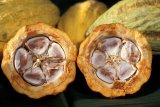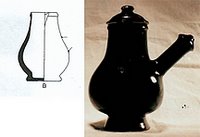Je propose un plat principal de Côte de grillé Boeuf servi avec Poivrade et un côté du l'ancienne d'à de farcies de Croûtes.
Côte de Boeuf
2 biftecks de Salers
beurre non salé de 1 cuiller à soupe
sel de cuillère à café de ¼
poivre fraîchement rectifié de cuillère à café de ¼
sucre de cuillère à café de ¼ (brun ou crus)
Poivrade
Des égouttures après boeuf est grillées
1 petit oignon, haché
Vinaigre ou verjus dans la casserole de deglaze
Zeste orange
Grains de poivre fraîchement fendus
Croûtes
baguette de 4 tranches, libéralement balayée avec du beurre et grillée
Confiture d'oranges d'oignon (oignons et thym caramélisés rôtis par four)
Fromage de Salers AOC, râpé
Sel, poivre et sucre de mélange ; frottez sur des biftecks de nervure. Grillez les biftecks à votre cuisson désirée en beurre non salé dans la casserole très chaude. Recouvrez les nervures de mode en spirale au centre du plateau de portion. Couvrez lâchement et placez en four de chauffage.
Oignon haché de Sauté en égouttures dans la casserole et la casserole de deglaze avec du vinaigre (verjus). Remuez en zeste orange et poivre criqué. Versez le jus au-dessus des biftecks.
Garnissez avec Croûtes qui ont été remplis de confiture d'oranges d'oignon et complétés avec du fromage râpé de Salers AOC et le beurre fondu et brunis. Appétit de fève !
This edition of Blog Appétit #11 pairs Salers beef, well-marbled and from an ancient breed, and fruity, strong Salers AOC cow’s milk cheese. Because I live in Nouvelle France, I no longer have access to these varieties, but can approximate the meat by Charolaise/Longhorn crossbreed beef; tasty and not too lean. An 18thC cut of beef is Côte de Boeuf, rib steak with bone-in, and one of the prime cuts of beef.
I propose a main dish of grilled Côte de Boeuf served with Poivrade and a side of Croûtes farcies à l’ancienne.
Côte de Boeuf
2 Salers steaks
1 tablespoon unsalted butter
¼ teaspoon salt
¼ teaspoon freshly ground pepper
¼ teaspoon sugar (brown or raw)
Poivrade
Drippings after beef is grilled
1 small onion, minced
Vinegar or verjus to deglaze pan
Orange zest
Freshly cracked peppercorns
Croûtes
4 slices baguette, liberally brushed with butter and toasted
Onion marmalade (oven roasted caramelized onions and thyme)
Salers AOC cheese, grated
Mix salt, pepper and sugar; rub onto Salers rib steaks. Grill steaks to your desired doneness in unsalted butter in very hot pan. Overlap ribs in spiral fashion in center of serving platter. Cover loosely and set in warming oven.
Sauté minced onion in drippings in pan and deglaze pan with vinegar (verjus). Stir in orange zest and cracked pepper. Pour jus over steaks.
Garnish with Croûtes which have been filled with onion marmalade and topped with grated Salers AOC cheese and melted butter and browned. Bon appétit!






 Ordinarily one chocolate tablet [
Ordinarily one chocolate tablet [
